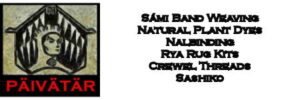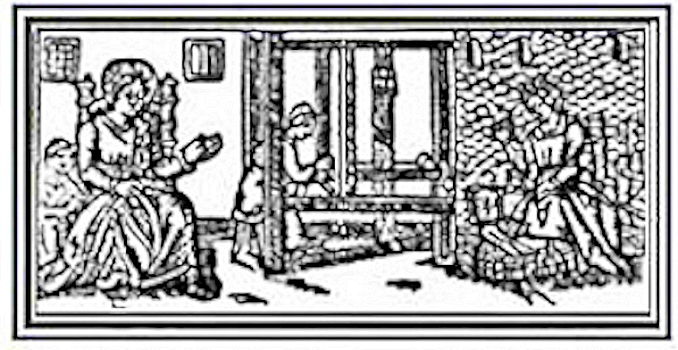Naalbinding Handwarmers Pattern
A Naalbinding pattern to stitch a pair of hand warmers using the Finnish 2+2 Stitch. In the Finnish 2 plus 2 stitch, after picking up the new stitch from the previous row, 2 loops are picked up from behind the thumb, the needle is turned counter-clockwise and 2 remaining stitches are picked up from on the thumb.
This creates a thicker nalbound cloth that is better suited for warm mittens.
When working a nalbinding pattern, the stitch count is never exact because the stitches are formed by making loops on your thumb, and everyone’s thumb size is different. Sometimes to make smaller stitches, the stitch can be tightened to the size of the needle, before pulling the loops through. Therefore, it is important to measure the item as you make it. Measure the beginning loops around your wrist if making handwarmers, measure around your head if making a hat, measure around your foot if making slippers or socks, or measure against another completed item.
All Naalbinding stitches are interlocking. The stitches do not unravel as they do in knitting or crochet. It is possible to un-work a stitch if you have made an error but this is tedious as all the yarn has to be pulled out through the stitches, one by one. If you make a bit of an error in the stitch, try not to worry about it but carry on with your project. Nalbinding work tends to felt well, especially if using wool, so the errors won’t really show badly. Plus Nalbinding is made by human hands, not machine. The wearer will be reminded of this and of the maker, as they wear the garment.
The Yarn
For these handwarmers, I am using a Japanese Noro Yarn – Ito. The Noro yarns are woollen spun, single ply using pure wools and dyed in multi-shade colours as well as the natural wool shades of the Haunui yarns . The Noro yarns are a DK weight (200 m/100 gr). Lovecrafts carries a good selection of the Noro Yarns and ships worldwide.
I like to use the woollen spun, single ply yarns for Nalbinding, partly because that is how yarns were traditionally spun. A single ply yarn doesn’t have as much twist as a plied yarn so it will gently felt as the garment is worn, making it warmer and more waterproof. In a woolen spun yarn, the fibres are gently carded and not combed, so the fibres do not align in one direction, but interlock with each other, creating small air spaces in the wool, resulting in better insulation. If the yarn has been properly spun it shouldn’t pull apart while gently stitching the nalbinding.
You can of course, use any plied yarn as well and it doesn’t have to be wool – cotton, silk, or any fibre will work. Finer weight yarns should be sized during stitching to fit the width of the small needle, otherwise you get a finished product that looks like it is full of holes or netting. (Nalbinding would be a good method for making a netted shopping bag!)
Nalbinding is worked in short lengths of yarn (1-4 meters in length) as the full length of yarn has to be pulled through each stitch. The ends can be joined together by wetting the end of the old yarn and the new yarn and felting it together by rubbing with your hands.
I prefer to use a technique called the ‘Russian Join’ where a loop is formed at the end of the old yarn, and interlocked with another loop at the start of the new yarn.
Because Naalbinding is worked with short lengths of yarn, this technique is well suited for using up your yarn stash. You can use different colours and overdye the finished piece to give the article a more harmonized look if you wish.
The Pattern
I used a ball of Noro Ito wool yarn (400 meters/200 gram)
I worked the Finnish 2+2 stitching in the round for 8 rows, checking the size (both width and length often) to ensure that I was stitching to the correct size. I highly recommend that if you are stitching mittens or socks, or anything that you need 2 of, that you work both of them at the same time to make sure that they are both the same size.
To form the space for the thumb, I stitched 20 chain stitches for the thumb loop, skipped over 12 stitches on the previous row and then joined the loop to the previous row.


Continue to work the Handwarmer in the round for another 6 rows or until the handwarmer is the correct length to fit your hand.
To finish, thread the yarn through the final loop and sew the end to the back of the work for a few stitches. Cut the thread.
Working the Thumb

Attach a new length of yarn to one of the corners of the thumb. Work the stitches using the Finnish 2+2 stitch around the base of the thumb, picking up stitches along the row as before: 25+12 stitches = 32 stitches.
The thumb decreases happen quite quickly over the next 3-4 rows – to about 18 stitches remaining at the end of the open thumb. Make one stitch, skip a stitch, make the next stitch. Try on the mitten often, every few stitches to ensure that the decreases are occurring evenly so that the thumb of the mitten fits your hand.
Sew in the thread ends and cut the remaining threads.
YouTube
 LONGTHREAD MEDIA VIDEO
LONGTHREAD MEDIA VIDEO
 LONGTHREAD MEDIA SUBSCRIPTIONS
HANDWOVEN MAGAZINE
PIECEWORK MAGAZINE
SPINOFF MAGAZINE
LEARN LONGTHREAD MEDIA
PAIVATAR HANDMADE
LONGTHREAD MEDIA SUBSCRIPTIONS
HANDWOVEN MAGAZINE
PIECEWORK MAGAZINE
SPINOFF MAGAZINE
LEARN LONGTHREAD MEDIA
PAIVATAR HANDMADE
 Paivatar on YouTube
Visit my YouTube channel for how-to craft videos.
Paivatar on YouTube
Visit my YouTube channel for how-to craft videos.
Or Please visit my Channel on Rumble for more how-to videos.
https://rumble.com/Paivatar
LIVE STREAMS - Paivatar Studio
KICK
TWITCH MAKERS&CRAFTING
YOUTUBE
Categories: NALBINDING



